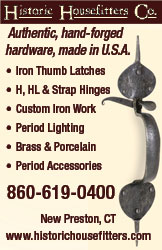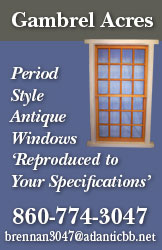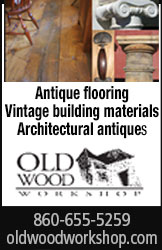Home Structural Products & Services, Stairlifts Structural Products & Services, Stairlifts Furniture, Clocks,
Accessories
Reclaimed Stone Materials
Woodwork, Blinds,
Finishing
Lighting
Kitchen
Floors & Rugs
Fabrics
Paint & Wallpaper Pottery & Tile
Period Hardware Antiques, Folk Art,
Fine Art, Auction Houses
Windows
Interior Design & Architecture
Silver, Cookware, Pewter
Garden
Historic Hotels |
PRATT HOUSE MUSEUM, 1732
20 West Avenue, Essex

|
In 1701 John Pratt, Jr. , grandson of Lt. William Pratt, one of the three original settlers of Essex, built a small gambrel-roofed cape on this site. By 1732, with a family of nine children and probably some elderly parents as well, he undoubtedly needed some more space. John moved this house back on the property and built in its place a two-room cape, one room down and one room up, with an end chimney. John, Jr. died about 1744 and the house passed to his son,Lt. John Pratt, who extended the house to a full cape. One more renovation toward the end of the18th century raised the roof to make it a two-story structure and to connect the early gambrel cape as an ell at the rear of the house.
In architectural terms the house is described as “vernacular” style, as it does not follow the classic symmetry of the Colonial period: there are four windows across the second floor façade instead of the usual five and they do not line up with the first floor windows or doorway; the chimney is not centered; the interior now has two L-shaped bedrooms, and there is no entry-hall or front stairs. The house remained in the Pratt family until 1952, when it was deeded to the Society for the Preservation of New England Antiquities (now known as Historic New England) by Mrs. Samuel Griswold, whose late husband was a Pratt on his mother’s side. In 1985, Historic New England transferred the property and much of its contents to the Essex Historical Society. |

|
Pratt House Furnishings
The furnishings, although not from the Pratt family, nevertheless span the years which the Pratts lived in the house and represent pieces they might have owned. They offer a range of styles, from the early Pilgrim oak chest to the graceful Queen Anne and Chippendale chairs and tables, and on through the Hepplewhite and Sheraton periods.
Also of particular interest are the collections of red-ware pottery, a group of courting mirrors, and the very beautiful iron door-latches, cooking utensils and fireplace tools, probably forged by one or more of the Pratt smithies. And not to be missed is the 18th century loom in the barn- it was a gift to the Society from the local house where it had been in use for many years. It was lovingly re-assembled in the loft of the Pratt House Barn and is worked on by a dedicated group of weavers who turn out prize-winning examples of traditional samples. |


|
Pratt Blacksmith Shop
Jack Pratt Sr., the first in the family line of blacksmiths, began his shop in Saybrook and later moved to Essex. His son, John, Jr., was a part-time blacksmith and the builder of Pratt House. Following the family trade in blacksmithing and living in the family homestead were three more generations of Pratts: Lt. John, Asa, and another John.The last four blacksmiths in the family who did not occupy the house were Elias, Edwin, James and another Edwin, for a total of nine continuous generations in the trade. The present Pratt Smithy building, located two doors east of Pratt House, was built in 1848 by Elias Pratt. It replaced an earlier wooden structure next door to the west. Their business specialized in household iron works- nails, hinges, latches, bolts, foot scrapers, tongs, gridirons and other house, farm and shipyard iron. Later horseshoeing became an important part of the business.
Open Sunday 1-4 p.m.
For information call 860-767-0681 |
|

 

  

 
  




|

 Structural Products & Services, Stairlifts
Structural Products & Services, Stairlifts